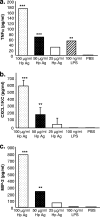Partial protection against Helicobacter pylori in the absence of mast cells in mice
- PMID: 19822650
- PMCID: PMC2786470
- DOI: 10.1128/IAI.00532-09
Partial protection against Helicobacter pylori in the absence of mast cells in mice
Abstract
The goal of this study is to evaluate the contribution of mast cells to Helicobacter pylori immunity in a model of vaccine-induced protection. Mast cell-deficient Kitl(Sl)/Kitl(Sl-d) and control mice were immunized with H. pylori sonicate plus cholera toxin and challenged with H. pylori, and the bacterial loads, inflammatory infiltrates, and cytokine responses were evaluated and compared at 1, 2, and 4 weeks postchallenge. In vitro stimulation assays were performed using bone marrow-derived mast cells, and recall assays were performed with spleen cells of immunized mast cell-deficient and wild-type mice. Bacterial clearance was observed by 2 weeks postchallenge in mast cell-deficient mice. The bacterial load was reduced by 4.0 log CFU in wild-type mice and by 1.5 log CFU in mast cell-deficient mice. Neutrophil numbers in the gastric mucosa of immune Kitl(Sl)/Kitl(Sl-d) mice were lower than those for immune wild-type mice (P < 0.05). Levels of gastric interleukin-17 (IL-17) and tumor necrosis factor alpha (TNF-alpha) were also significantly lower in immune Kitl(Sl)/Kitl(Sl-d) mice than in wild-type mice (P < 0.001). Immunized mast cell-deficient and wild-type mouse spleen cells produced IFN-gamma and IL-17 in response to H. pylori antigen stimulation. TNF-alpha and CXC chemokines were detected in mast cell supernatants after 24 h of stimulation with H. pylori antigen. The results indicate that mast cells are not essential for but do contribute to vaccine-induced immunity and that mast cells contribute to neutrophil recruitment and inflammation in response to H. pylori.
Figures






Similar articles
-
Vaccine-induced immunity against Helicobacter pylori in the absence of IL-17A.Helicobacter. 2011 Jun;16(3):169-78. doi: 10.1111/j.1523-5378.2011.00839.x. Helicobacter. 2011. PMID: 21585602 Free PMC article.
-
Vaccination of mice against H pylori induces a strong Th-17 response and immunity that is neutrophil dependent.Gastroenterology. 2009 Jan;136(1):247-56. doi: 10.1053/j.gastro.2008.09.017. Epub 2008 Sep 20. Gastroenterology. 2009. PMID: 18948106 Free PMC article.
-
Mast cells are critical mediators of vaccine-induced Helicobacter clearance in the mouse model.Gastroenterology. 2005 Jul;129(1):142-55. doi: 10.1053/j.gastro.2005.04.010. Gastroenterology. 2005. PMID: 16012944
-
The Importance of CXCL1 in the Physiological State and in Noncancer Diseases of the Oral Cavity and Abdominal Organs.Int J Mol Sci. 2022 Jun 28;23(13):7151. doi: 10.3390/ijms23137151. Int J Mol Sci. 2022. PMID: 35806156 Free PMC article. Review.
-
Clinical significance of tumor necrosis factor-alpha and carcinoembryonic antigen in gastric cancer.J Med Life. 2022 Jan;15(1):4-6. doi: 10.25122/jml-2020-0098. J Med Life. 2022. PMID: 35186129 Free PMC article. Review.
Cited by
-
Muc1 cell surface mucin attenuates epithelial inflammation in response to a common mucosal pathogen.J Biol Chem. 2010 Jul 2;285(27):20547-57. doi: 10.1074/jbc.M110.121319. Epub 2010 Apr 29. J Biol Chem. 2010. PMID: 20430889 Free PMC article.
-
Molecular Interactions between MUC1 Epithelial Mucin, β-Catenin, and CagA Proteins.Front Immunol. 2012 May 7;3:105. doi: 10.3389/fimmu.2012.00105. eCollection 2012. Front Immunol. 2012. PMID: 22566976 Free PMC article.
-
IL-22-induced antimicrobial peptides are key determinants of mucosal vaccine-induced protection against H. pylori in mice.Mucosal Immunol. 2017 Jan;10(1):271-281. doi: 10.1038/mi.2016.38. Epub 2016 May 4. Mucosal Immunol. 2017. PMID: 27143303
-
Vaccine-induced immunity against Helicobacter pylori in the absence of IL-17A.Helicobacter. 2011 Jun;16(3):169-78. doi: 10.1111/j.1523-5378.2011.00839.x. Helicobacter. 2011. PMID: 21585602 Free PMC article.
-
Suppression of IL-8 production in gastric epithelial cells by MUC1 mucin and peroxisome proliferator-associated receptor-γ.Am J Physiol Gastrointest Liver Physiol. 2012 Sep 15;303(6):G765-74. doi: 10.1152/ajpgi.00023.2012. Epub 2012 Jul 5. Am J Physiol Gastrointest Liver Physiol. 2012. PMID: 22766852 Free PMC article.
References
-
- Akhiani, A. A., J. Pappo, Z. Kabok, K. Schon, W. Gao, L. E. Franzen, and N. Lycke. 2002. Protection against Helicobacter pylori infection following immunization is IL-12-dependent and mediated by Th1 cells. J. Immunol. 169:6977-6984. - PubMed
-
- Blanchard, T. G., S. J. Czinn, R. W. Redline, N. Sigmund, G. Harriman, and J. G. Nedrud. 1999. Antibody-independent protective mucosal immunity to gastric Helicobacter infection in mice. Cell. Immunol. 191:74-80. - PubMed
-
- Blanchard, T. G., J. C. Eisenberg, and Y. Matsumoto. 2004. Clearance of Helicobacter pylori infection through immunization: the site of T cell activation contributes to vaccine efficacy. Vaccine 22:888-897. - PubMed
-
- Czinn, S. J., A. Cai, and J. G. Nedrud. 1993. Protection of germ-free mice from infection by Helicobacter felis after active oral or passive IgA immunization. Vaccine 11:637-642. - PubMed
Publication types
MeSH terms
Substances
Grants and funding
LinkOut - more resources
Full Text Sources
Medical
Molecular Biology Databases

